|
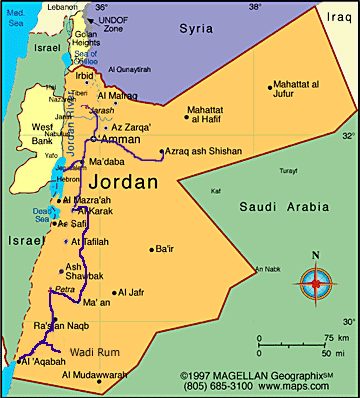 Jordan is located in the Middle East, bordered by Israel, Syria, Iraq and Saudi Arabia. It is mountainous to the west, mostly desert, although there are fertile areas in the Jordan Valley near the Dead Sea. It has one seaport, Aqaba, on the Red Sea. Jordan is located in the Middle East, bordered by Israel, Syria, Iraq and Saudi Arabia. It is mountainous to the west, mostly desert, although there are fertile areas in the Jordan Valley near the Dead Sea. It has one seaport, Aqaba, on the Red Sea.
We came to Jordan in January, 2006 on a one-week tour with a Spanish tour group. Since this area of the world is unsettled due to the Iraq war, it is not the best place or time for Americans to pursue independent travel. Since we were staying in Spain, traveling with a Spanish tour group was easy to arrange, provides a bit of cover, and gave us a fun, lively group of people to travel with. The dark blue lines on the map above show our route through the country.
We began our tour in the capital city, Amman, using this as a base for touring the sites in the northern part of the country. The city of Amman itself does not have many tourist sites, though we did a drive-through tour to see the shopping area and the King Hussein Mosque.
The ruins of Jerash to the north of Amman was our first stop. Jerash has been inhabited by a variety of people over the ages, including Greek, Roman, 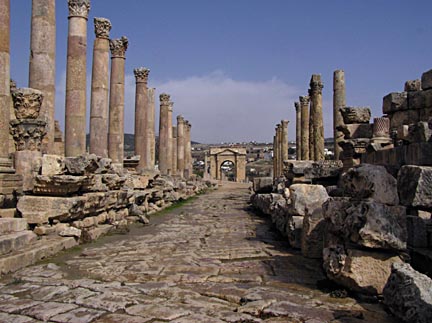 Byzantine, Umayyad and others. Its golden age arrived with the Roman rule and it was a member of Decapolis, a dynamic commercial league of 10 Greco-Roman cities. Most of the visible ruins date from this era. Still standing (or restored) are temples, churches, fountains, a theater, a market area and great colonnaded streets as well as the large oval plaza and triumphal arches. It is quite an impressive collection of ruins and is one of the best preserved Roman sites outside of Italy. The photo at left is a view looking north along the Cardo to the North Gate (115 AD). Click here for a slide show of Jerash. Byzantine, Umayyad and others. Its golden age arrived with the Roman rule and it was a member of Decapolis, a dynamic commercial league of 10 Greco-Roman cities. Most of the visible ruins date from this era. Still standing (or restored) are temples, churches, fountains, a theater, a market area and great colonnaded streets as well as the large oval plaza and triumphal arches. It is quite an impressive collection of ruins and is one of the best preserved Roman sites outside of Italy. The photo at left is a view looking north along the Cardo to the North Gate (115 AD). Click here for a slide show of Jerash.
This area saw many battles between the Muslims and the Crusaders. One remnant of these times can be seen in the Aljun Castle in the north (photo, below), built by a nephew of Saladin to protect the area from the Crusaders. It commands a hilltop location in the northern Jordan valley and was one of a chain of forts, used to pass signals from the Euphrates to as far as Cairo.
To the south of Amman is a an example of a fortress built by the crusaders, the castle of Karak. As with Aljun Castle, Karak was built on the hilltop to have an unobstructed view of the entire surrounding area. As you can see from the photo of the castle below left, it is an impressive sight and pretty much dominates the hilltop, although the town has now built up to the castle as seen on the right side of the photo.
The desert is dotted with various castles, farming estates, forts, hunting lodges and caravansaries. It is quite amazing as you drive for an hour or so, seeing nothing but a few goat herders or some Bedouin tents. Then, in the middle of nowhere rises a big stone building. If you stop, you will find that it is a caravansary (a desert hotel) or perhaps a caliph’s resort home. One hunting lodge, Qusayr ‘Amra has its interior walls covered with colorful and lively frescoes from Umayyad times during the 8th century. While the exterior of the lodge is basic stone and relatively simple, the visitor is immediately surprised with the vivid frescoes found inside (the photo above right shows a portion of the ceiling).
Another worth mentioning is of course Al Azraq (below left) which was used by Lawrence of Arabia in 1917 during the Arab Revolt against the Ottomans. This is an amazing fortress made of the local black basalt and took its final form in 1237. Even the ceilings and roofs are formed by thick long pieces of the basalt. The entrance doors are made with single slabs of granite that open by rotating in a depression in the granite sill.
Click here for a slide show of the Crusader and Desert Castles.
There are many Biblical sites in Jordan as well. Mt. Nebo is one of them, the presumed site of Moses’ death and burial place. The basilica built on the site still contains some lovely mosaics from the 6th century, as the photo above right shows. The river Jordan is also considered a revered site as is the site where John the Baptist was living when he baptized Jesus. Other sites that we did not visit include the city of Salt and Lot’s cave, both associated with the story of Lot.
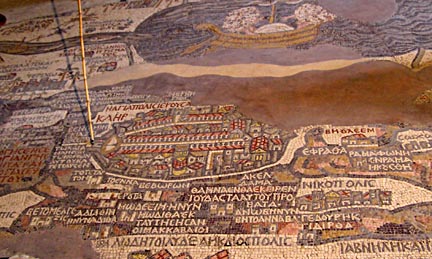 At Madaba a small Orthodox church is the site of an amazing mosaic depicting the holy lands (left). The mosaic dates from the 6th century and originally measured over 16 meters long by 6 meters wide. There are still large portions visible. It is believed that the mosaic originally was intended to serve as a guide to pilgrims traveling from one holy site to another. The city of Jerusalem is featured at the center of the map (where the stick is pointing). At Madaba a small Orthodox church is the site of an amazing mosaic depicting the holy lands (left). The mosaic dates from the 6th century and originally measured over 16 meters long by 6 meters wide. There are still large portions visible. It is believed that the mosaic originally was intended to serve as a guide to pilgrims traveling from one holy site to another. The city of Jerusalem is featured at the center of the map (where the stick is pointing).
Heading further south, we finally arrived at Petra, truly the highlight of anyone’s visit to Jordan. Petra sits in the southern desert and is amazing sight of tombs, early Bedouin homes, and Roman ruins. It takes an entire day to see Petra and even then we didn’t see it all. It was disappointing to see visitors who came only to see the Siq and the Treasury, the sites made famous by the Indiana Jones film.
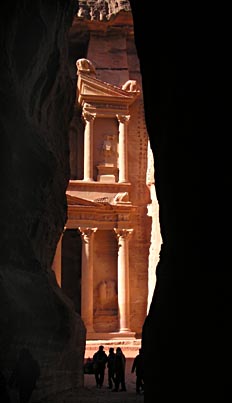 As expected, it was truly beautiful to walk through the Siq, the narrow gorge of red sandstone leading into the main area. At each turn, a new vista appears, more striking than the last. Eventually you arrive at the end of the Siq and catch just a glimpse of the Treasury (photo at right) - just like in the movie! But it is really only when you see the full size of the Treasury (which is really just a tomb) that you begin to be awed by the power of the place. Past the Treasury you finally enter the main city of Petra. Here there is a theater, many royal tombs, temple facades and hundreds of caves carved into the rock walls. Further on are the Roman ruins and 1,000 steps above the city you will find the Monastery from the 1st century AD. Although not as finely carved as the Treasury, its size and setting make it all that more impressive. As expected, it was truly beautiful to walk through the Siq, the narrow gorge of red sandstone leading into the main area. At each turn, a new vista appears, more striking than the last. Eventually you arrive at the end of the Siq and catch just a glimpse of the Treasury (photo at right) - just like in the movie! But it is really only when you see the full size of the Treasury (which is really just a tomb) that you begin to be awed by the power of the place. Past the Treasury you finally enter the main city of Petra. Here there is a theater, many royal tombs, temple facades and hundreds of caves carved into the rock walls. Further on are the Roman ruins and 1,000 steps above the city you will find the Monastery from the 1st century AD. Although not as finely carved as the Treasury, its size and setting make it all that more impressive.
Click here for a slide show of Petra.
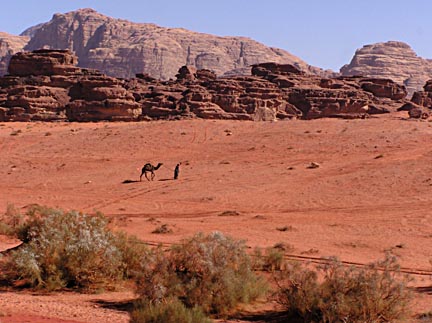 South of Petra is the desert area known as Wadi Rum. “Vast, echoing and God-like” are the words that T. E. Lawrence used to describe Wadi Rum. This sandy desert is punctuated by massive rock formations in golden and red rock (photo at left). Here you can take a ride in 4-wheel drive vehicle or on a camel to further investigate the desert past the villages and paved roads. Lawrence of Arabia actually used this area as a base during the Arab Revolt and much of the movie was filmed here. But that aside, we really enjoyed the landscape and wished we had the sidecar with us so we could really enjoy it! South of Petra is the desert area known as Wadi Rum. “Vast, echoing and God-like” are the words that T. E. Lawrence used to describe Wadi Rum. This sandy desert is punctuated by massive rock formations in golden and red rock (photo at left). Here you can take a ride in 4-wheel drive vehicle or on a camel to further investigate the desert past the villages and paved roads. Lawrence of Arabia actually used this area as a base during the Arab Revolt and much of the movie was filmed here. But that aside, we really enjoyed the landscape and wished we had the sidecar with us so we could really enjoy it!
Click here for a slide show of the Wadi Rum.
We ended our short tour with a visit to Aqaba on the Red Sea, the only sea port in Jordan. It was Friday, a non-working day, so the city was full of locals shopping, visiting the seaside, and enjoying the air show going on overhead in honor of the King’s birthday. We thoroughly enjoyed our visit to Jordan and would recommend it for others of a like mind. For more views of everyday life in Jordan, click here.
|

 Jordan is located in the Middle East, bordered by Israel, Syria, Iraq and Saudi Arabia. It is mountainous to the west, mostly desert, although there are fertile areas in the Jordan Valley near the Dead Sea. It has one seaport, Aqaba, on the Red Sea.
Jordan is located in the Middle East, bordered by Israel, Syria, Iraq and Saudi Arabia. It is mountainous to the west, mostly desert, although there are fertile areas in the Jordan Valley near the Dead Sea. It has one seaport, Aqaba, on the Red Sea. Byzantine, Umayyad and others. Its golden age arrived with the Roman rule and it was a member of Decapolis, a dynamic commercial league of 10 Greco-Roman cities. Most of the visible ruins date from this era. Still standing (or restored) are temples, churches, fountains, a theater, a market area and great colonnaded streets as well as the large oval plaza and triumphal arches. It is quite an impressive collection of ruins and is one of the best preserved Roman sites outside of Italy. The photo at left is a view looking north along the Cardo to the North Gate (115 AD). Click here for a slide show of
Byzantine, Umayyad and others. Its golden age arrived with the Roman rule and it was a member of Decapolis, a dynamic commercial league of 10 Greco-Roman cities. Most of the visible ruins date from this era. Still standing (or restored) are temples, churches, fountains, a theater, a market area and great colonnaded streets as well as the large oval plaza and triumphal arches. It is quite an impressive collection of ruins and is one of the best preserved Roman sites outside of Italy. The photo at left is a view looking north along the Cardo to the North Gate (115 AD). Click here for a slide show of 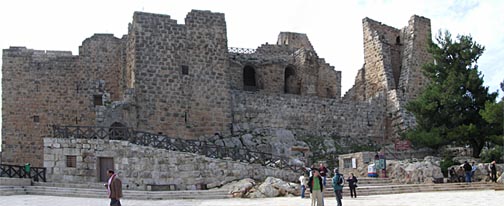
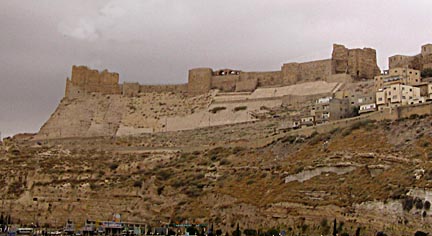
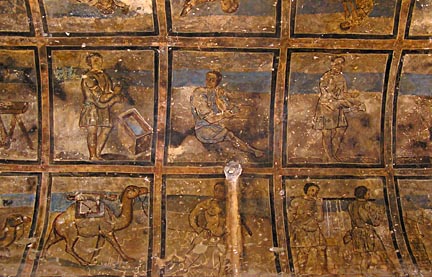
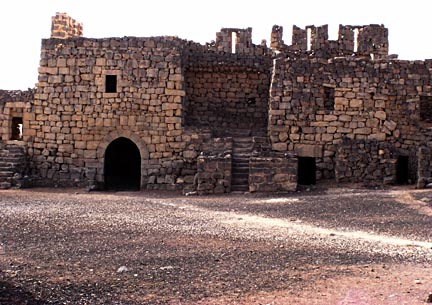
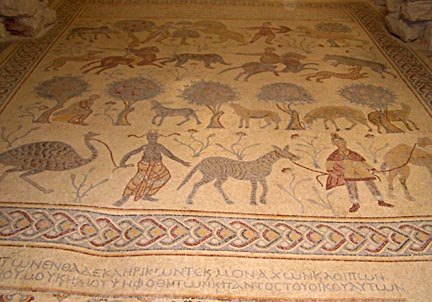
 At Madaba a small Orthodox church is the site of an amazing mosaic depicting the holy lands (left). The mosaic dates from the 6th century and originally measured over 16 meters long by 6 meters wide. There are still large portions visible. It is believed that the mosaic originally was intended to serve as a guide to pilgrims traveling from one holy site to another. The city of Jerusalem is featured at the center of the map (where the stick is pointing).
At Madaba a small Orthodox church is the site of an amazing mosaic depicting the holy lands (left). The mosaic dates from the 6th century and originally measured over 16 meters long by 6 meters wide. There are still large portions visible. It is believed that the mosaic originally was intended to serve as a guide to pilgrims traveling from one holy site to another. The city of Jerusalem is featured at the center of the map (where the stick is pointing). As expected, it was truly beautiful to walk through the Siq, the narrow gorge of red sandstone leading into the main area. At each turn, a new vista appears, more striking than the last. Eventually you arrive at the end of the Siq and catch just a glimpse of the Treasury (photo at right) - just like in the movie! But it is really only when you see the full size of the Treasury (which is really just a tomb) that you begin to be awed by the power of the place. Past the Treasury you finally enter the main city of Petra. Here there is a theater, many royal tombs, temple facades and hundreds of caves carved into the rock walls. Further on are the Roman ruins and 1,000 steps above the city you will find the Monastery from the 1st century AD. Although not as finely carved as the Treasury, its size and setting make it all that more impressive.
As expected, it was truly beautiful to walk through the Siq, the narrow gorge of red sandstone leading into the main area. At each turn, a new vista appears, more striking than the last. Eventually you arrive at the end of the Siq and catch just a glimpse of the Treasury (photo at right) - just like in the movie! But it is really only when you see the full size of the Treasury (which is really just a tomb) that you begin to be awed by the power of the place. Past the Treasury you finally enter the main city of Petra. Here there is a theater, many royal tombs, temple facades and hundreds of caves carved into the rock walls. Further on are the Roman ruins and 1,000 steps above the city you will find the Monastery from the 1st century AD. Although not as finely carved as the Treasury, its size and setting make it all that more impressive. South of Petra is the desert area known as Wadi Rum. “Vast, echoing and God-like” are the words that T. E. Lawrence used to describe Wadi Rum. This sandy desert is punctuated by massive rock formations in golden and red rock (photo at left). Here you can take a ride in 4-wheel drive vehicle or on a camel to further investigate the desert past the villages and paved roads. Lawrence of Arabia actually used this area as a base during the Arab Revolt and much of the movie was filmed here. But that aside, we really enjoyed the landscape and wished we had the sidecar with us so we could really enjoy it!
South of Petra is the desert area known as Wadi Rum. “Vast, echoing and God-like” are the words that T. E. Lawrence used to describe Wadi Rum. This sandy desert is punctuated by massive rock formations in golden and red rock (photo at left). Here you can take a ride in 4-wheel drive vehicle or on a camel to further investigate the desert past the villages and paved roads. Lawrence of Arabia actually used this area as a base during the Arab Revolt and much of the movie was filmed here. But that aside, we really enjoyed the landscape and wished we had the sidecar with us so we could really enjoy it!